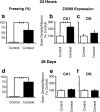Cellular imaging of zif268 expression in the hippocampus and amygdala during contextual and cued fear memory retrieval: selective activation of hippocampal CA1 neurons during the recall of contextual memories
- PMID: 11245703
- PMCID: PMC6762622
- DOI: 10.1523/JNEUROSCI.21-06-02186.2001
Cellular imaging of zif268 expression in the hippocampus and amygdala during contextual and cued fear memory retrieval: selective activation of hippocampal CA1 neurons during the recall of contextual memories
Abstract
The neuroanatomical and molecular basis of fear memory retrieval was studied by analyzing the expression of the plasticity-associated immediate early gene zif268. Cellular quantitative in situ hybridization revealed that zif268 is expressed within specific regions of the hippocampus and amygdala during fear memory retrieval. Within the hippocampus, increased expression of zif268 was observed within CA1 neurons, but not dentate gyrus neurons, during the retrieval of contextual, but not cued, fear associations. In contrast, zif268 expression was increased within neurons of the amygdala (lateral, basal, and central nuclei) during the retrieval of both contextual and cued fear memories. These results demonstrate activation of hippocampal CA1 neurons in contextual fear memory retrieval that was not merely a correlate of the behavioral expression of fear itself, because it was limited to the retrieval of contextual, and not cued, fear memories. Further studies revealed that the selective increase in hippocampal CA1 zif268 expression seen after contextual fear memory retrieval was limited to the retrieval of recent (24 hr) but not older (28 d) memories. These experiments represent the first demonstration that zif268 expression in specific neuronal populations is associated with memory retrieval and suggest that this gene may contribute to plasticity and reconsolidation accompanying the retrieval process.
Figures




References
-
- Aggleton JP. The functional effects of amygdala lesions in humans: a comparison with findings from monkeys. In: Aggleton JP, editor. The amygdala: neurobiological aspects of emotion, memory, and mental dysfunction. Wiley-Liss; New York: 1992. pp. 485–504.
-
- Amaral DG, Witter MP. Hippocampal formation in the rat nervous system. In: Paxinos G, editor. The rat nervous system. Academic; London: 1995. pp. 443–494.
-
- Amorapanth P, LeDoux JE, Nader K. Differential lateral amygdala outputs mediate reactions and actions elicited by a fear-arousing stimulus. Nat Neurosci. 2000;3:74–79. - PubMed
-
- Bellgowan PSF, Helmstetter FJ. Effects of muscimol applied to the dorsal hippocampus on the acquisition and expression of cued versus contextual fear conditioning. Soc Neurosci Abstr. 1995;21:478.
Publication types
MeSH terms
Substances
Grants and funding
LinkOut - more resources
Full Text Sources
Miscellaneous
